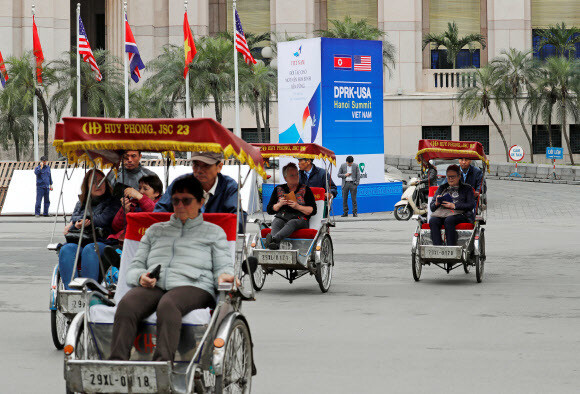hankyoreh
Links to other country sites 다른 나라 사이트 링크
Vietnam as a model of development and sanctions removal for North Korea

Vietnam, the host country for the second North Korea-US summit, has achieved growth levels ranging from five to 450 times in various economic indicators including growth, investment, imports and expertise over the 23 to 38 years since the 1980s to 1990s through a combination of internal reform and openness measures and a process of the US lifting its economic sanctions. Analysts suggested a similar progress to that sanctions removal – which stretched out over more than two decades – could also apply in the case of lifting US economic sanctions against North Korea.
A report titled “Removal of Economic Sanctions in Response to North Korean Denuclearization” published on Feb. 25 by the Korea Institute for International Economic Policy (KIEP) noted that Vietnam achieved an annual economic growth rate of 6.4% over the 28-year period from 1980 to 2017 amid the three phases of its Doi Moi economic reform policies since 1986 and the normalization of relations with the US and other Western nations. Its nominal GDP rose nearly eightfold from US$27.84 billion in 1980 to US$220.4 billion in 2017, while per capita nominal GDP quintupled from US$514 to US$2,354 over the same period.
“Examination of Vietnamese GDP trends over the past 20 to 30 years shows it to have achieved economic growth amid improvements in its external relations with the US,” the report said.
“After laying a foundation for economic growth during the 1990s, internally with Doi Moi and externally with its withdrawal from Cambodia, [Vietnam] went on to establish diplomatic relations with the US in 1995 (with a trade embargo lifted in 1994), sign a trade agreement with the US in 2001, acquire the foreign direct investment (FDI) and official development assistance (ODA) necessary for economic growth through WTO membership in 2006, and achieve rapid growth in imports and exports,” it noted.
The report also analyzed influences on changes in Vietnamese economic indicators amid progress in normalizing relations with the US. The amount of FDI entering Vietnam rose sharply with its 2001 signing of a trade agreement with the US and 2006 membership in the WTO. As the trade agreement led to Vietnam rapidly emerging an indirect export base for the US, FDI rose from US$120 million in 1990 to US$15.8 billion in 2016 – a difference of 132 times. Cumulative FDI inflows over this period totaled US$154.6 billion. ODA also began a trend of major increase with the 1991 signing of a peace agreement with Cambodia, permission from the Clinton administration for international financial institutions to resume support in 1993, and the 1995 establishment of diplomatic relations with the US.
Totaling US$230 million in 1991, ODA rose to US$570 million the following year after the peace agreement was signed. By 2000, it had reached US$1.68 billion; as of 2016, it totaled US$2.889 billion – a roughly 23-fold increase.

US responsible for little direct investment in Vietnam, but direct role in trade increase
The report noted that while the normalization of ties with the US played a major part in the foreign investment inflows into Vietnam, the actual scale of direct US investment in Vietnam has not been large. The US’ portion of total FDI in Vietnam fell from 10% in 1995 to under 3% in 2007; as of 2016, the US was not ranked among the top 10 countries for investment. A similar pattern has occurred with ODI.
“Since the normalization of relations, the US has not taken part directly in assistance to Vietnam, but it appears to have played a role in the inflows of foreign investment into Vietnam indirectly by using its influence with major international financial organizations or sending signals to the international community,” KIEP said.
In the area of trade, the US has played a direct role in propelling an increase in total imports and exports. Vietnamese imports and exports rose from respective totals of US$5.82 billion and US$4.05 billion in 1994 to US$174.8 billion and US$176.58 billion in 2016. Total trade has increased by a factor of 68, including a 73-fold rise in exports and 63-fold rise in imports. Prior to the signing of the 2001 trade agreement, the US market accounted for less than 5% of total Vietnamese exports; that percentage has since risen to 20% as Vietnam has emerged as an indirect US export base. In 2017, Vietnamese exports to the US totaled US$42.68 billion, up by a factor of 450 from when the trade embargo was lifted in 1994.
Process of sanctions removal in Vietnam was gradual
“An observation of the process of the US lifting its economic sanctions against Vietnam shows that it began early on with things that had only a minor effect on the Vietnamese economy, including the loosening of travel restrictions on Vietnamese diplomats and regulations of Vietnamese travel by US citizens, before proceeding to the removal of sanctions with a large impact on the economy, including permissions on Vietnamese assistance by international financial institutions in 1993 and the subsequent loosening of trade-related sanctions,” KIEP explained.
“Some time was needed to proceed from areas where [sanctions] could be lifted by the decision of the US president alone and his executive order powers to the final removal, which required the approval of Congress,” it added.
The institute also predicted that “the same process as in the US removal of economic sanctions against Vietnam and normalization of economic relations is expected to be applied with North Korea.”
By Cho Kye-wan, staff reporter
Please direct comments or questions to [english@hani.co.kr]

Editorial・opinion
![[Editorial] Intensifying US-China rivalry means Seoul must address uncertainty with Beijing sooner than later [Editorial] Intensifying US-China rivalry means Seoul must address uncertainty with Beijing sooner than later](https://flexible.img.hani.co.kr/flexible/normal/500/300/imgdb/original/2024/0517/8117159322045222.jpg) [Editorial] Intensifying US-China rivalry means Seoul must address uncertainty with Beijing sooner than later
[Editorial] Intensifying US-China rivalry means Seoul must address uncertainty with Beijing sooner than later![[Column] When ‘fairness’ means hate and violence [Column] When ‘fairness’ means hate and violence](https://flexible.img.hani.co.kr/flexible/normal/500/300/imgdb/original/2024/0516/7417158465908824.jpg) [Column] When ‘fairness’ means hate and violence
[Column] When ‘fairness’ means hate and violence- [Editorial] Yoon must stop abusing authority to shield himself from investigation
- [Column] US troop withdrawal from Korea could be the Acheson Line all over
- [Column] How to win back readers who’ve turned to YouTube for news
- [Column] Welcome to the president’s pity party
- [Editorial] Korea must respond firmly to Japan’s attempt to usurp Line
- [Editorial] Transfers of prosecutors investigating Korea’s first lady send chilling message
- [Column] Will Seoul’s ties with Moscow really recover on their own?
- [Column] Samsung’s ‘lost decade’ and Lee Jae-yong’s mismatched chopsticks
Most viewed articles
- 1For new generation of Chinese artists, discontent is disobedience
- 2[Editorial] Transfers of prosecutors investigating Korea’s first lady send chilling message
- 3[Exclusive] Unearthed memo suggests Gwangju Uprising missing may have been cremated
- 4[Editorial] Intensifying US-China rivalry means Seoul must address uncertainty with Beijing sooner t
- 5S. Korea “monitoring developments” after report of secret Chinese police station in Seoul
- 6N. Korean media upgrades epithet for leader’s daughter from “beloved” to “respected”
- 7Yoon says concern about biased diplomacy is being incited by “communist totalitarian forces”
- 8[Column] US troop withdrawal from Korea could be the Acheson Line all over
- 9Xi, Putin ‘oppose acts of military intimidation’ against N. Korea by US in joint statement
- 1060% of young Koreans see no need to have kids after marriage